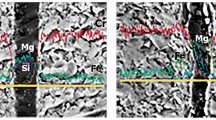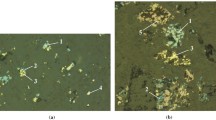The composition and structure of periclase-chromite refractories contacting the coal–gas atmosphere of copper-sulfide-ore smelting furnaces were studied. Combined effects of high-temperature suspensions of enriched copper concentrate and SO2 altered the chemical composition of the refractory surface and inner layers. The impurity contents (wt%) reached Fe 54.0, Cu 7.2, Zn 6.4, and S 1.8. Saturation of the surface layer with iron and nonferrous-metal oxides decreased its porosity and promoted the formation of low-melting compounds and eutectics. The periclase-chromite refractories were decomposed by exfoliation of layers with filled pores during alternating heat—cool cycles because of the different linear thermal expansion coefficients of the phases. The surface layer of spent refractories should be mechanically removed for recycling. The remaining part is suitable for producing refractory powders for various purposes.





Similar content being viewed by others
References
A. M. Klyushnikov, K. V. Pikulin, V. V. Belyaev, et al., “Structure of periclase-chromite refractories after the service life in furnaces for the processing of sulfide raw material,” Refract. Ind. Ceram., 58(5), 481 – 486 (2018).
N. Z. Fotoyi and R. H. Eric, “Interaction of MgO–MgR2O4 (R: Al, Cr, Fe) with SO2-containing gasses,” Southern African Pyrometallurgy 2011 International Conference, Johannesburg, March 6 – 9, 2011, pp. 373 – 388.
E. N. Selivanov, “Impregnation of a periclase-chromite lining with nickel matte,” Ogneupory Tekh. Keram., No. 6, 28, 29 (1995).
L. M. Aksel’rod, T. V. Yarushina, I. G. Maryasev, et al., “Chromite-periclase refractory wear in zinc production waelz kiln reaction zone,” Refract. Ind. Ceram., 57(6), 563 – 568 (2017).
T. I. Shchekina, A. M. Batanova, T. N. Kurbyko, et al., “Comparative study of chromitepericlase and periclase-carbon refractory stability during reaction with nickel production melts (experimental data). 1. Behavior of chromite-periclase refractories in the presence of metal-slag and slag melts,” Refract. Ind. Ceram., 55(6), 516 – 528 (2015).
V. G. Kozhin, V. V. Belyaev, and E. N. Selivanov, “Improving the refractory lining durability of pyrometallurgical plants in service at the Svyatogor Joint-Stock Co.,” Refract. Ind. Ceram., 45(4), 228 – 231 (2004).
A. V. Vanyukov and N. I. Utkin, Complex Processing of Copper and Nickel Ores: Textbook for Higher Educational Institutions [in Russian], Metallurgiya, Chelyabinsk Branch, Chelyabinsk, 1988, 432 pp.
D. I. Gavrish (ed.), Refractory Production: Guide in Two Volumes, Vol. 2, Metallurgiya, Moscow, 1965, 584 pp.
I. D. Kashcheev, K. K. Strelov, and P. S. Mamykin, Chemical Engineering of Refractories: Study Aide [in Russian], Intermet Inzhiniring, Moscow, 2007, 752.
N. I. Kopylov, M. P. Smirnov, and M. Z. Toguzov, Phase Diagrams in Metallurgy of Heavy Nonferrous Metals [in Russian], Metallurgiya, Moscow, 1993, 302 pp.
M. E. Schlesinger, M. J. King, K. C. Sole, and W. G. Davenport, Extractive Metallurgy of Copper, Elsevier Ltd., 2011, 481 pp.
N. V. Mel’nikov, V. V. Rzhevskii, and M. M. Protod’yakonov (eds.), Handbook of Physical Properties of Rocks [in Russian], Nedra, Moscow, 1975, 279 pp.
A. G. Khoroshavin, Forsterite 2MgO·SiO 2 [in Russian], Teplotekhnik, Moscow, 2004, 368 pp.
J. Allenstein, et al., in: G. Routschka and H. Wuthnow (eds.), Pocket Manual Refractory Materials: Design, Properties, Testing, 3rd Ed. [translated from German], Intermet Inzhiniring, Moscow, 2010, 392 pp.
O. A. Konovalova, V. Yu. Zagorodnov, S. M. Karimov, et al., “ Use of scrap of refractory articles in the technology employed in the fabrication of flux,” Refract. Ind. Ceram., 56(1), 14 – 16 (2015).
Author information
Authors and Affiliations
Corresponding author
Additional information
Translated from Novye Ogneupory, No. 12, pp. 31 – 36, December, 2018.
Rights and permissions
About this article
Cite this article
Klyushnikov, A.M., Selivanov, E.N., Pikulin, K.V. et al. Periclase-Chromite Refractory Decomposition by a Coal – Gas Medium During Copper Sulfide Raw Material Processing. Refract Ind Ceram 59, 642–647 (2019). https://doi.org/10.1007/s11148-019-00288-z
Received:
Published:
Issue Date:
DOI: https://doi.org/10.1007/s11148-019-00288-z




